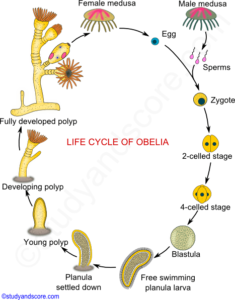Back to: ZOOLOGY 200 Level
I’m excited to have you with me as we explore another fascinating aspect of the animal world today. In this lesson, we’re going to look at Nematocysts and Life Cycles in Hydra and Obelia. These are some of the most interesting features of cnidarians, the group that includes creatures like jellyfish and sea anemones. Ready to get started? Let’s go!
Nematocysts, life cycles (Hydra, Obelia
What are nematocysts?
Nematocysts are specialised cells found in cnidarians, such as hydra, jellyfish, and sea anemones. They are tiny, powerful capsules that contain a harpoon-like structure, which is used to inject toxins into prey or predators. These cells are located in the tentacles of cnidarians and are crucial for both defence and hunting.

When a cnidarian’s tentacle comes into contact with a potential prey or threat, the nematocyst is triggered and rapidly shoots out the harpoon, which penetrates the target. This is often followed by the release of venom to immobilise the prey or deter the predator. The nematocyst’s rapid action is a remarkable feature of cnidarian biology.
In hydra, the nematocysts are used to catch small aquatic animals like crustaceans, which the hydra then consumes. Similarly, in jellyfish, these cells are used to capture plankton, which makes up a large portion of their diet. The effectiveness of nematocysts in both capturing food and defending against threats cannot be overstated.
Life cycle of Hydra
Hydra is a small, freshwater cnidarian that exhibits both asexual and sexual reproduction. Its life cycle is quite simple but very interesting.

The asexual reproduction of hydra typically occurs through a process called budding. During this process, a small bud forms on the body of the parent hydra, eventually growing into a new, genetically identical individual. Once the bud is fully developed, it detaches from the parent and begins its independent life.
When conditions are right, hydra can also reproduce sexually. In this case, they produce eggs and sperm. The sperm fertilises the eggs, and the fertilised eggs develop into tiny larvae called planulae. These larvae settle on a surface and eventually develop into adult hydra. The sexual reproduction phase helps to introduce genetic diversity into the population.
Life cycle of Obelia
Obelia is another cnidarian that has a more complex life cycle involving both polyp and medusa forms, similar to what we discussed earlier. It begins its life as a polyp, which is a stationary form that attaches to rocks or other surfaces in the water.
The polyp reproduces asexually by budding, producing more polyps or tiny medusae. The medusae eventually detach from the polyp and are free-swimming. These medusae then reproduce sexually, releasing sperm and eggs into the water. When the eggs are fertilised, they develop into larvae known as planulae, which settle on a surface and eventually become new polyps, continuing the cycle.

This alternation between the polyp and medusa forms is called alternation of generations, and it allows Obelia to reproduce efficiently and adapt to various environmental conditions.
Summary
Nematocysts are specialised cells in cnidarians that help them capture prey and defend themselves. Hydra has a simple life cycle with both asexual and sexual reproduction, while Obelia has a more complex life cycle with both polyp and medusa forms. The life cycles of these organisms allow them to thrive in their environments by adapting to different reproductive strategies.
Evaluation
- What are nematocysts and what role do they play in cnidarians?
- Describe the asexual reproduction method in hydra.
- How does the life cycle of Obelia differ from that of hydra?
- What is the significance of nematocysts for hydra and jellyfish?
You’ve just learned about two of the most interesting life cycles in the animal kingdom! Nematocysts are amazing, and the life cycles of Hydra and Obelia are crucial to understanding the complexity of life in cnidarians. Keep up the good work, and let’s continue exploring the wonders of Zoology. Afrilearn is always here to support you on this journey.
